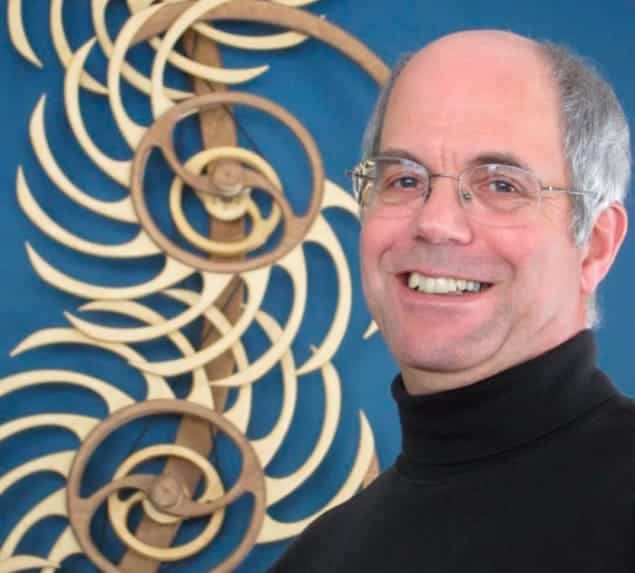David Roy is a sculptor who produces spring-driven moving artworks through his company Wood that Works

Why did you choose to study physics?
My interest in science started very early, probably with science-fiction books like the Tom Swift series, which are aimed at children. After brief stints in chemistry and engineering, I chose to study physics at Boston University because I found it the most challenging. I also had dreams of being an “inventor” and thought physics would give me an understanding of how things worked.
How did you become interested in sculpture?
Towards the end of my degree, I started spending time at the Rhode Island School of Design, where my future (and present!) wife Marji was studying sculpture and art education. The world of art was new to me, and I was particularly fascinated by some static wooden machine sculptures she had constructed. I kept suggesting that she make them move but she was not interested and suggested I try instead. After I graduated in 1974, I started working as a computer programmer for an insurance company. It was a tedious job that involved long periods of waiting, so during those downtimes I started sketching ideas for small kinetic toys. I left the programming job after nine months and started Wood That Works by selling these toys at local craft fairs. The toy designs evolved into the first kinetic wall sculptures. I had found a way to invent, but it was in an area I had never dreamed of.
How are your sculptures constructed?
All of my work is driven by constant-force springs, which use a two-spool set-up where a stainless-steel spring band is wound from one spool back against its natural coil direction onto a second spool. As the spring fights to return to its original form, it provides a fairly even torque over the full length of the band. This mimics the torque provided by a traditional clock-weight drive, but in a more compact form. The concept of a constant-force spring confuses many people, because they think of it as a constant-velocity spring motor – something that will turn a wheel at a constant rotational speed. That is not the case: the torque or force is constant, but the unregulated rotating wheel will just keep accelerating until the spring is fully unwound – often creating quite a mess!
So from a purely mechanical view, my sculptures are devices that regulate the unwinding of a spring. Over the years, I have invented quite a few different mechanisms to do this, starting with the concept of clock escapements and extending it to create longer, more active action cycles and random motion. I have two major advantages over clock designers: my works do not have to run for days and they do not have to keep time. Instead, my goal is to create interesting patterns of motion that keep moving (and entertaining) for hours.
How does your training in physics help?
It is essential to my career as a kinetic sculptor. Knowledge of basic mechanics is a necessity, but the analytical study and problem-solving skills that I developed as a physics student have been, if anything, far more important. The intense initial design period when I was visualizing the concept of spring-driven kinetic sculptures felt very much like the long days and nights at university when I tried to get my head round advanced physics concepts.



